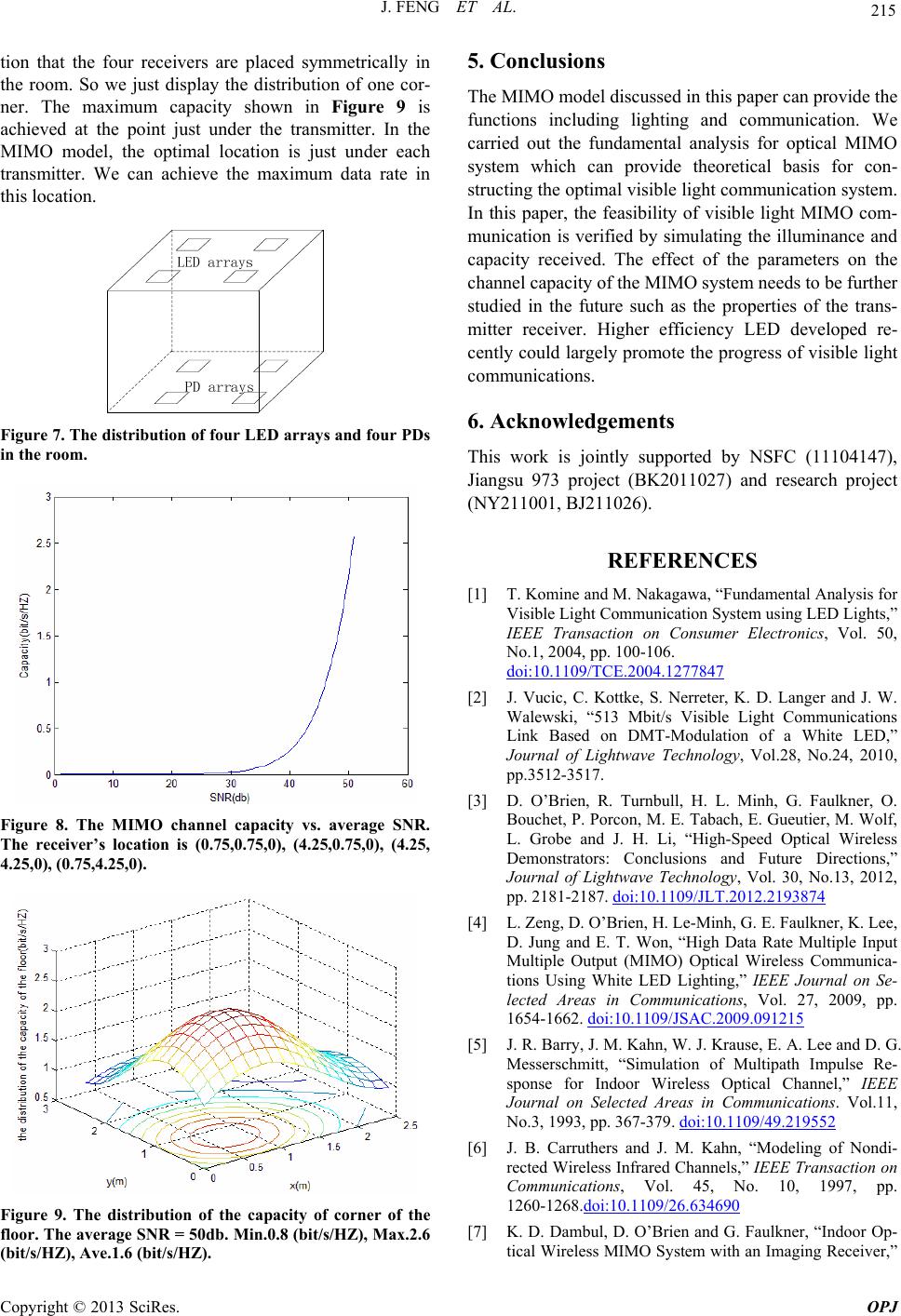
J. FENG ET AL. 215
tion that the four receivers are placed symmetrically in
the room. So we just display the distribution of one cor-
ner. The maximum capacity shown in Figure 9 is
achieved at the point just under the transmitter. In the
MIMO model, the optimal location is just under each
transmitter. We can achieve the maximum data rate in
this location.
Figure 7. The distribution of four LED array s and four PDs
in the room.
Figure 8. The MIMO channel capacity vs. average SNR.
The receiver’s location is (0.75,0.75,0), (4.25,0.75,0), (4.25,
4.25,0), (0.75,4.25,0).
Figure 9. The distribution of the capacity of corner of the
floor. The average SNR = 50db. Min.0.8 (bit/s/HZ), Max.2.6
(bit/s/HZ), Ave.1.6 (bit/s/HZ).
5. Conclusions
The MIMO model discussed in this paper can provide the
functions including lighting and communication. We
carried out the fundamental analysis for optical MIMO
system which can provide theoretical basis for con-
structing the optimal visible light communication system.
In this paper, the feasibility of visible light MIMO com-
munication is verified by simulating the illuminance and
capacity received. The effect of the parameters on the
channel capacity of the MIMO system needs to be further
studied in the future such as the properties of the trans-
mitter receiver. Higher efficiency LED developed re-
cently could largely promote the progress of visible light
communications.
6. Acknowledgements
This work is jointly supported by NSFC (11104147),
Jiangsu 973 project (BK2011027) and research project
(NY211001, BJ211026) .
REFERENCES
[1] T. Komine and M. Nakagawa, “Fundamental Analysis for
Visible Light Communication System using LED Lights,”
IEEE Transaction on Consumer Electronics, Vol. 50,
No.1, 2004, pp. 100-106.
doi:10.1109/TCE.2004.1277847
[2] J. Vucic, C. Kottke, S. Nerreter, K. D. Langer and J. W.
Walewski, “513 Mbit/s Visible Light Communications
Link Based on DMT-Modulation of a White LED,”
Journal of Lightwave Technology, Vol.28, No.24, 2010,
pp.3512-3517.
[3] D. O’Brien, R. Turnbull, H. L. Minh, G. Faulkner, O.
Bouchet, P. Porcon, M. E. Tabach, E. Gue utier, M. Wolf,
L. Grobe and J. H. Li, “High-Speed Optical Wireless
Demonstrators: Conclusions and Future Directions,”
Journal of Lightwave Technology, Vol. 30, No.13, 2012,
pp. 2181-2187. doi:10.1109/JLT.2012.2193874
[4] L. Zeng, D. O’Brien, H. Le-Minh, G. E. Faulkner, K. Lee,
D. Jung and E. T. Won, “High Data Rate Multiple Input
Multiple Output (MIMO) Optical Wireless Communica-
tions Using White LED Lighting,” IEEE Journal on Se-
lected Areas in Communications, Vol. 27, 2009, pp.
1654-1662. doi:10.1109/JSAC.2009.091215
[5] J. R. Barry, J. M. Ka hn, W. J. Krau se, E. A. Lee and D. G.
Messerschmitt, “Simulation of Multipath Impulse Re-
sponse for Indoor Wireless Optical Channel,” IEEE
Journal on Selected Areas in Communications. Vol.11,
No.3, 1993, pp. 367-379. doi:10.1109/49.219552
[6] J. B. Carruthers and J. M. Kahn, “Modeling of Nondi-
rected Wireless Infrared Channels,” IEEE Transaction on
Communications, Vol. 45, No. 10, 1997, pp.
1260-1268.doi:10.1109/26.634690
[7] K. D. Dambul, D. O’Brien and G. Faulkner, “Indoor Op-
tical Wireless MIMO System with an Imaging Receiver,”
Copyright © 2013 SciRes. OPJ